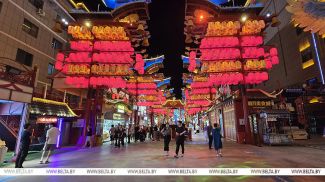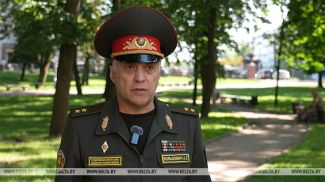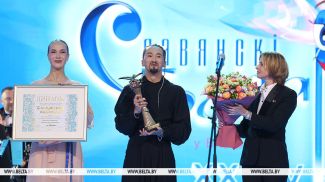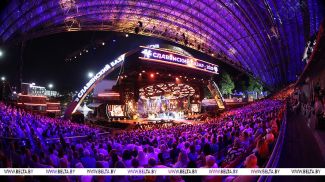I remember my first visit to the China-Belarus industrial park Great Stone well. Back then it was one big empty field, figuratively speaking, because part of the area allocated for the industrial park was still heavily forested. The facilities included the stone, which had been placed there as part of the groundbreaking ceremony, and a one-story U-shaped structure. In one of its rooms visitors could see a detailed breadboard model of the future industrial park while the other rooms were converted to office space. I was welcomed by Kirill Koroteyev, First Deputy Director General of SZAO Industrial Park Development Company, who was optimistically talking and showing what would be accomplished in the park and how awesome it would be.
I was leaving the place with mixed feelings. On the one hand, it was impossible not to believe in the project, knowing that not only resources of my own country, but the might of China stood ready to implement the project. On the other hand, standing in the field with patches of forest, it was difficult to imagine that so many buildings would rise here regardless of how beautiful the presentations were.
It's been about three years since then. Over the course of the three years the construction of the China-Belarus industrial park Great Stone was covered in detail and regularly on site. But only during my last visit I came to recognize that so much had been done already, including the things that had seemed impossible, and that I overflow with pride and eagerness to spread the word about these accomplishments.
Just like three years ago we were welcomed by Kirill Koroteyev next to an eight-story administrative building, which had replaced the crude U-shaped structure. Not only BelTA reporters visited the industrial park back then. The park welcomed participants of the Belarusian Investment Forum, primarily foreigners, who came to see with their own eyes what they had heard so much about.
The construction of the new administrative building is now in the phase where systems are being commissioned and defects are being fixed. It is scheduled to open in late October. Kirill Koroteyev said: “We — the managing company — will be the first to move in. A total of about 80 people. The park administration will start working here next year. Taking into account the distance from Minsk, we intend to arrange bus service to transport personnel from and to Minsk several times per day. Meanwhile, we are dealing with catering problems and considering the possibility of having a bank outlet opened. I would like you to understand that all the processes, which make one's work comfortable, will become fully active only after people are permanently present here.”
Pictured are the conference hall and the premises where the park administration will put the one-stop investment principle into practice. Investors will no longer have to contact various government agencies one after another. All they will have to do is to come here and say they are ready to cooperate. The government agencies will have to assign officers to the park upon request for the sake of fulfilling administrative procedures.
This is the professional way of treating investors. With a pinch of humor the locals say: “Those, who come here, will leave only as residents of the park”.
The roof of the administrative building offers an unprecedented view of the surrounding area. The land plot surrounded by the blue fence has been given to OOO Zoomlion Bel-Rus. There are plans to make utility vehicles over there, including construction machines, concrete mixer trucks, concrete pump trucks, automobile cranes, street sweeping vehicles, and other kinds of municipal vehicles. The investments will exceed $30 million.
The resident company with American investments — OOO Ruchtech — is about to start construction over there. It will be a manufacturing factory with a design bureau geared towards the development and production of automated laser systems for macro and micro processing of metals, alloys, and composites. It will also make optic-mechanical components for various kinds of equipment. “It is a project with quite advanced technologies. We've been working on it for about a year to prove that Belarus will offer the competitive edge the project needs to come to fruition,” said Kirill Koroteyev.
Fiber-optic cables have many applications varying from machine tool engineering to surgery. A unique technology will be used to make lasers and consumer-grade equipment for specific projects. Lasers can be used in very small equipment packages, even as small as a matchbox. The intended investments stand at $30 million.
It is a manufacturing wing the Industrial Park Development Company has built in order to rent it to resident companies. All the premises have been reserved already. For instance, the Belarusian company OOO Assomedika is nearly finished designing the last few engineering systems the facility needs. OOO China Telecom BLR is not a resident company but has already invested $1 million, is settling in, and is about to start installing equipment for the automatic telephone station that will cater to the entire industrial park.
“When we were designing manufacturing wings, we were not completely sure they will be in demand. In the end the idea worked well. We will begin building another manufacturing wing soon. By the way, one third of its premises has already been reserved. There are plans to build two more buildings like or a total of four manufacturing wings for now,” explained Kirill Koroteyev.
In spring 2018 the managing company will start building an innovation center. The center will occupy about 19,000m2 and will be built at the expense of China's technical and economic aid. “The center will have to assist with the development of startups. But applied science will be in focus. According to the concept the same building will house office premises and manufacturing labs where prototypes can be made. We would like new technologies to be developed in our industrial park,” said Kirill Koroteyev.
OOO Chengdu Xinzhu Silk Road Development is one of the first five resident companies in the China-Belarus industrial park Great Stone. The company will make supercapacitors as well as equipment and materials for railway transport in the park. The investments stand at $5 million.
But everything we've seen up till now pales in comparison with the facilities built by ZAO China Merchants CHN-BLR Commerce and Logistics. A trade and expo center is one of them. The construction of the building with the total area of 22,000m2 began in spring 2016, which means that Belarus' largest expo center up to date has been built within 1.5 years. The center is supposed to open in November-December 2017, but one can already obtain access to it.
“As a matter of fact, it is a logistics subpark where the full package of services will be available: clients will be able to get familiar with products, make choices and orders here. Plans have been made to use the exhibition premises to showcase products by the park's residents and Belarusian companies. An exhibition of industrial robots can be arranged here since one of the resident companies will specialize in making fire-extinguishing robots,” said Kirill Koroteyev.
Next to the trade and logistics center China Merchants Group has built a business center, which is supposed to open in October.
A hotel for 65 people is part of the business center. It will not get any stars since no random visitors will be allowed inside. But there are plans to build a four- or five-star hotel for 350 people near it soon. The hotel will be run by the Hong Kong chain China Travel Service. It will be the first step in the company's efforts to penetrate the Belarusian market. If everything goes well, the hotel operator may build a large entertainment center in the park.
According to Kirill Koroteyev, the managing company is about to sign the contract on building the second stage of the infrastructure as part of the efforts to use up the first 851ha of the park's territory. “There are plans to build 25-30km of motorways and roads inside the blocks. We already know where all the residents will be located. We know how the land plots will be shaped. This is why it is time to build blocks, build internal streets, and the accompanying engineering infrastructure. We intend to get down to it this month. The contactor has already been determined. The bulk of the work will be finished in 2018. Some work will be left for early 2019,” said Kirill Koroteyev.
Asked about new residents, Kirill Koroteyev mentioned the key piece of news of late: the German company Duisburger Hafen AG is about to become a shareholder in SZAO Industrial Park Development Company. Initially it will own 1 million shares. “Duisport, the port of Duisburg is the final point of the reemerging Silk Road. Trains already depart from Duisburg to cross Belarus and reach Urumqi and travel back. It would be logical to tie up the Silk Road on both ends,” explained Kirill Koroteyev.
Several aspects of this cooperation scheme look interesting to Belarus. In particular, the German partners boast key competences in the organization of industrial logistics. “Industrial logistics goes beyond storing and transporting products. It involves operations, which can be logically performed in a distribution hub,” said Kirill Koroteyev. “For instance, raw materials for making an internationally recognized energy drink and tin for making cans are delivered to the port of Duisburg. The end product is then made and transported all over the world. Thanks to this approach Duisburg evolved from a small port into the largest European hub over the course of 20 years. While their services are not cheap, clients come to them since they understand benefits of comprehensive manufacturing logistics.”
Apart from selling a minority stake in the managing company to the German partners there are plans to set up a joint railway hub in the China-Belarus industrial park Great Stone. “We have a land plot as large as about 50ha near the airport. There are plans to build a transshipping and logistics terminal there under the management of Duisburger Hafen AG and possibly in partnership with China Merchants Group. It is a medium-term perspective,” said Kirill Koroteyev.
At last there is a third component in cooperation with Duisburger Hafen AG: access to the client base of the German partners. “Duisburger Hafen AG caters to Germany's entire modern manufacturing industry such as producers of automobile components, computer equipment, electronics, and fine chemistry. In essence these are all the business types our park is supposed to attract. For instance, Duisburger Hafen AG maintains a very good partnership with DHL. If they arrived in Belarus, it would mean a lot,” assured Kirill Koroteyev.
On the whole, Kirill Koroteyev noted that investors are growing increasingly interested in the China-Belarus industrial park Great Stone. “We welcome delegations virtually every day. Those can be image-building meetings when visitors come to look around and leave shortly after that. Those can be real investors, who look at things very closely. Certainly, most of them have no concrete plans to accomplish something here but they leave with the right idea: a lot has already been accomplished in the park, it is now time to consider residency possibilities more seriously. The fact that China Merchants Group has built a logistics subpark and a business center is very important for us. If such a large company is busy building things here, then profits are definitely assured. We try to emphasize the fact for every guest. And certainly, we always tell visitors about the substantial advantages granted by presidential decree No.166,” said the executive.
There are plans to start building social infrastructure in the park in order to offer the full package of services to investors. The construction of the first rental house with 156 apartments is supposed to begin next spring. It will be erected thanks to China's technical aid. “The design we have suggested has been evaluated by Chinese experts. The bilateral procedures, which are necessary for starting the construction process, are about to commence. We intend to use the first floor of the building to open a post office, a bank outlet, a telecommunication office, and a police office. One room will be dedicated to maintenance and support personnel. The package of our proposals for Chinese partners also includes the construction of a clinic thanks to China's technical aid. We are taking it slowly. We will build the rental house first and then we'll see,” said Kirill Koroteyev.
The master plan provides building housing for 7,000-8,000 residents as part of the first development phase. Those will be low-story buildings, which will not disrupt the park's architectural style.
I'd love to end the report with this turret with the clock, because creators of the China-Belarus industrial park Great Stone face a most difficult task: theoretically they have to race ahead of time. If they manage to accomplish that, the project's economic effect is assured for many years to come.
By Yulia DYLENOK













